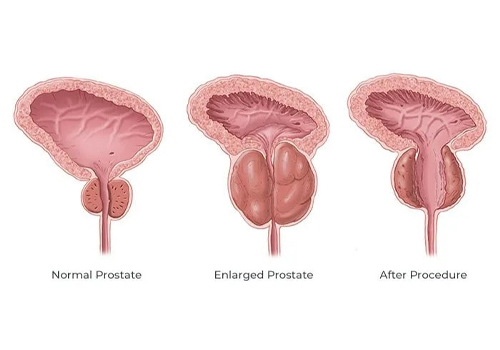
Prostate-TURP
Transurethral Resection of the Prostate (TURP) is a common surgical procedure to treat Benign Prostatic Hyperplasia (BPH), a condition where the prostate gland enlarges and obstructs urine flow. TURP is considered the gold standard treatment for moderate to severe symptoms of BPH.
Indications for TURP
TURP is recommended when BPH causes:
- Difficulty in urination (weak stream, straining).
- Recurrent urinary tract infections (UTIs).
- Urinary retention (inability to empty the bladder).
- Bladder stones or kidney damage due to long-term obstruction.
- Failure of medical management (e.g., alpha-blockers or 5-alpha reductase inhibitors).
Procedure Overview
- Anesthesia: TURP is usually performed under spinal or general anesthesia.
- Resection:
- A resectoscope is inserted through the urethra.
- The surgeon uses an electrically heated loop to shave off portions of the enlarged prostate blocking the urethra.
- Irrigation:
- Continuous irrigation of the bladder during the procedure helps remove blood and tissue.
- Completion:
- The removed tissue is sent for pathological examination.
- A urinary catheter is placed to drain the bladder and help with healing.
Advantages
- No external incisions (minimally invasive).
- High success rate for relieving symptoms.
- Can significantly improve urine flow and quality of life.
Disadvantages
- Requires hospital stay (usually 1–2 days).
- Potential side effects (see below).
Potential Side Effects and Risks
- Short-Term:
- Blood in urine (hematuria) for a few days post-surgery.
- Urinary tract infections.
- Temporary difficulty in urination.
- Long-Term:
- Retrograde Ejaculation: Semen enters the bladder instead of exiting through the penis (common but harmless).
- Erectile Dysfunction: Rare, but possible.
- Urethral Stricture or scarring.
- Need for re-treatment if prostate tissue regrows.
Recovery
- Hospital Stay: 1–2 days for catheter removal and monitoring.
- Pain Management: Minimal pain; over-the-counter pain relievers are usually sufficient.
- Return to Activities:
- Avoid heavy lifting and strenuous activities for 2–4 weeks.
- Gradual return to normal activities as advised by the doctor.
- Fluid Intake: Drink plenty of water to flush out the bladder and prevent clots.
Follow-Up
- Regular check-ups with the urologist to monitor recovery.
- Annual evaluations to ensure no recurrence of symptoms.
Alternatives to TURP
- Medication: Alpha-blockers (e.g., tamsulosin) or 5-alpha reductase inhibitors (e.g., finasteride).
- Minimally Invasive Procedures:
- GreenLight Laser PVP: Uses laser to vaporize prostate tissue.
- Urolift: Implants to lift and hold the prostate tissue.
- HoLEP (Holmium Laser Enucleation of the Prostate): Laser-based alternative to TURP.
When to Choose TURP
TURP is ideal for men with moderate to severe symptoms of BPH who have not responded to medications or have complications from the condition.
If you need detailed advice or have specific symptoms, consulting a urologist is recommended for personalized guidance.

